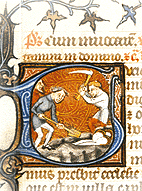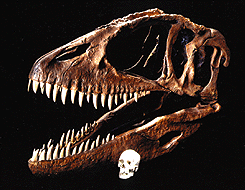 The University of Chicago Magazine June 1996
The University of Chicago Magazine June 1996
Return to June 1996 Table of Contents

- Macabre beliefs and an obsession with death permeated medieval life, writes art historian Michael Camille in Master of Death: The Lifeless Art of Pierre Remiet, Illuminator (Yale).
- The Law School's Cass Sunstein wonders: Is the Supreme Court truly supreme in debates on affirmative action, homosexuality, or the right to die?
- In a trip to Morocco, paleontologist Paul Sereno and team including four U of C grad students and one alumna make two (big) dinosaur discoveries.
- Political scientist Dali Yang weighs the sometimes tragic lessons of Mao's Great Leap Forward.
Citations
The Art of Dying.

In 14th-century Europe, merely looking at the plague-ridden could be life-threatening-or so it was said. Macabre beliefs and an obsession with death permeated medieval life, writes U of C art historian Michael Camille in Master of Death: The Lifeless Art of Pierre Remiet, Illuminator (Yale). Known to history only because of a blank space and a note reading, "Remiet, make nothing here," in an otherwise fully illuminated manuscript, the normally anonymous Parisian specialized in illustrating suffering, old age, death, and corporeal decay. Camille, who began tracing the prolific artist's work in 1981, shows that in Remiet's world, death was implicit at birth and dreaded doubly in fear of Judgment Day. Even Remiet avoided depicting the visible pall of sickness-his lepers are lesionless-perhaps as a result of the Black Death of 1348-49, believed to be spread through the eyes.The Best Judge.

Is the Supreme Court truly supreme in debates on affirmative action, homosexuality, or the right to die? No, said the Law School's Cass Sunstein in this year's Nora and Edward Ryerson Lecture, given in May. Speaking on the Dred Scott slavery case, the constitutional expert argued that courts preempt the political process when they attempt to settle society's "Great Questions."
Jaws of Africa.

Step down, T. rex. Edging out the king as largest predatory dinosaur are two discoveries, one by Chicago paleontologist Paul Sereno. In a trip to Morocco, Sereno's team, including four U of C grad students and one alumna, found the skull of the 45-foot-long Carcharodontosaurus saharicus, identified since 1927 only through puzzling fragments. (Inset shows its reconstructed skull next to a human skull; also see "Events.") The 90-million-year-old "shark-toothed reptile from the Sahara" wasn't the team's only triumph: Also uncovered was a new, fleet-footed species of dinosaur. Sereno's two finds clarify dinosaur evolution after the continents broke apart.
Days of Pain.

In the Great Leap Forward-Mao's utopian plan to jumpstart industrialization-communes banished household farms, building projects conscripted millions of peasants, and up to 40 million people starved to death. In Calamity and Reform in China: State, Rural Society, and Institutional Change since the Great Leap Famine (Stanford), U of C political scientist Dali Yang writes how out-of-touch leaders caused the 1957-61 disaster, how many peasants finally ignored their edicts, and how such contests between the elite and the masses still shape China's policies.

 The University of Chicago Magazine June 1996
The University of Chicago Magazine June 1996


